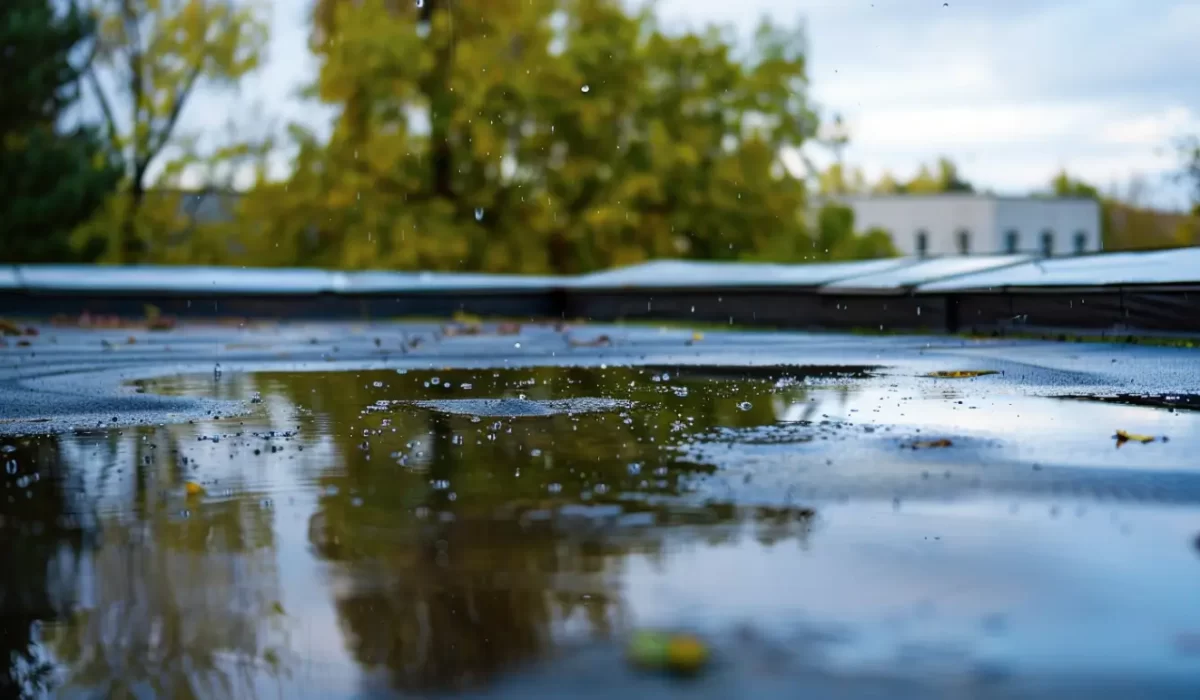Good roof drainage is very important for commercial roofing. This is true, especially in big buildings where design can make things tricky. Building owners and property managers, like those working with Fontaine Roofing in Anaheim, CA, need to know about water flow and how drainage works. When roof drainage is good, you can avoid water pooling, structural damage, and costly repairs. Regular maintenance and inspections by a pro, such as the experts at Fontaine Roofing, also help roofing materials last longer in these large roofs.
Understanding Drainage Challenges in Large Commercial Complexes
Managing water runoff in large commercial buildings can be challenging due to their extensive roofs and varying weather conditions. Proper runoff control is essential to prevent water pooling, which can lead to structural damage and material degradation over time.
Factors like roof slope, construction, and drainage point placement affect efficiency. Collaborating with roofing professionals for routine inspections ensures optimal system performance, helping you avoid costly repairs caused by inadequate drainage solutions.
Contact Us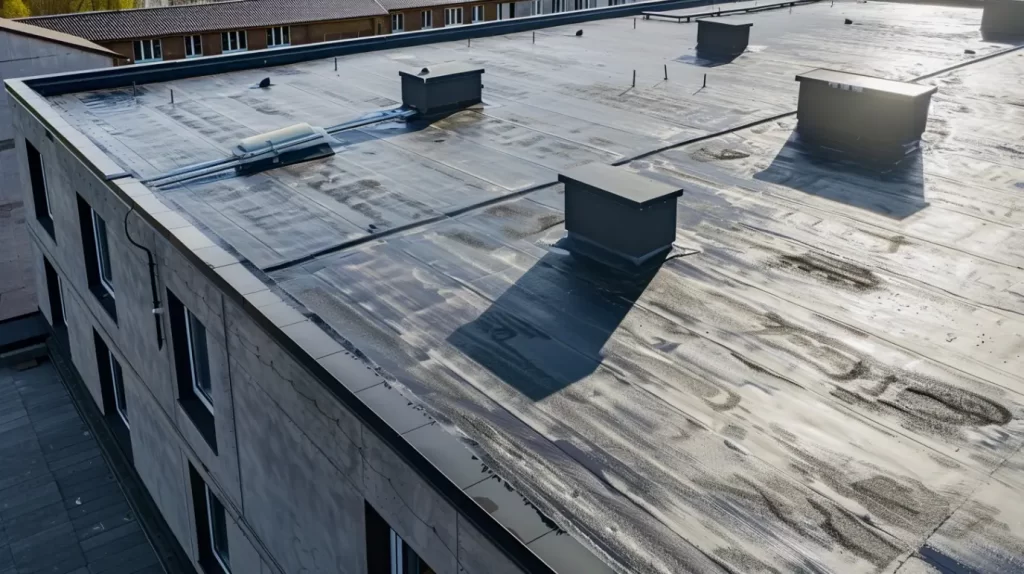
Why Roof Drainage Is Critical for Building Health
Effective roof drainage is crucial for maintaining a building’s safety and integrity. A good drainage system prevents water buildup, which protects roofing materials from damage and reduces the risk of costly repairs due to leaks or structural issues. Ensuring efficient water flow off the roof can save building owners on maintenance costs, extend the lifespan of roofing materials, and preserve property value. Proper drainage is essential for preventing water accumulation and material deterioration.
Unique Drainage Issues in Large-Scale Structures
Managing water flow in big buildings brings some big problems. The roofs have more surface area and many slopes. This can cause water pooling if no good plan is there. Heavy rainfall and debris accumulation on flat roofs can block drainage points and this can lead to ice dams, especially in colder climates. Large roofs can have structural issues when there is a lot of water. So, it is important to use the right water runoff systems to avoid costly repairs and to keep the roof in good shape.
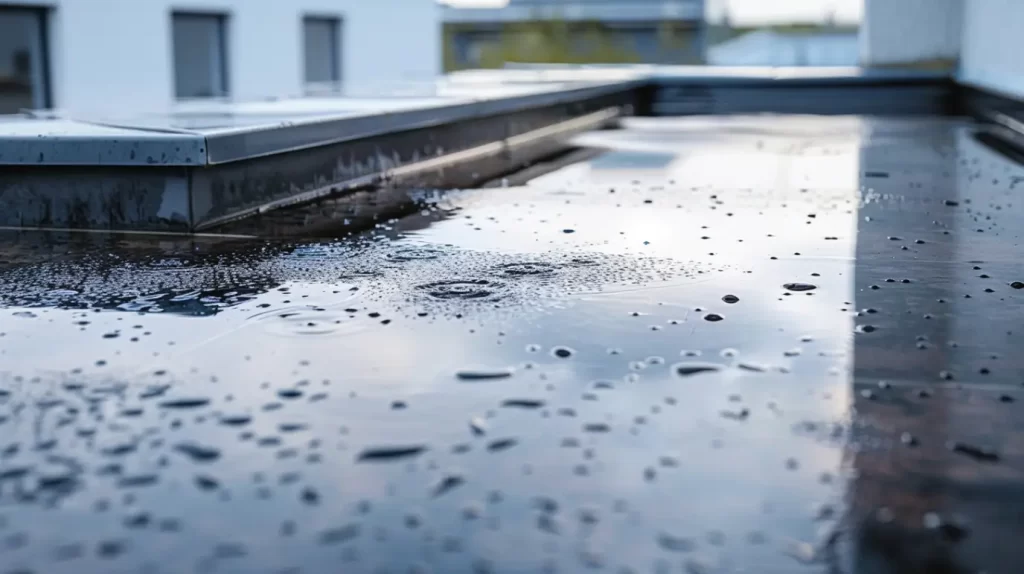
Key Components of Commercial Roof Drainage Systems
Good drainage systems use a few important parts to keep commercial roofs working well. Roof drains help move water off the roof surface, which stops water from building up and causing structural damage. Scuppers let water leave the roof from the edges. Gutters and downspouts help get water down to the ground fast. Picking the right set of these for your roof shape and needs is key. It helps the roofing system stay strong and last a long time by managing water flow in the best way.
Interior Drains vs. Exterior Drains: Pros and Cons
Choosing between interior and exterior drains requires understanding their strengths and potential issues.
Interior drains prevent water pooling on the roof and improve water flow but can clog with debris, risking water damage.
Exterior drains are positioned at the roof’s edge and effectively channel water away from the building, protecting the foundation. However, they may struggle during heavy rainfall or ice dams.
Both types require regular maintenance to minimize debris buildup and ensure efficient drainage, sometimes necessitating professional assistance.
Scuppers, Gutters, and Downspouts: Essential Roles
Scuppers, gutters, and downspouts have a crucial role in the water flow for roof runoff systems in big commercial buildings. These water removal systems help move water away from flat roofs, so heavy rainfall does not cause water pooling. They also help push water out from the roof edge and away from the building’s foundation. This can stop structural damage and stop water intrusion that could lead to costly repairs. To keep your roof in good shape and get the best runoff performance, you need regular checks and upkeep on these systems.
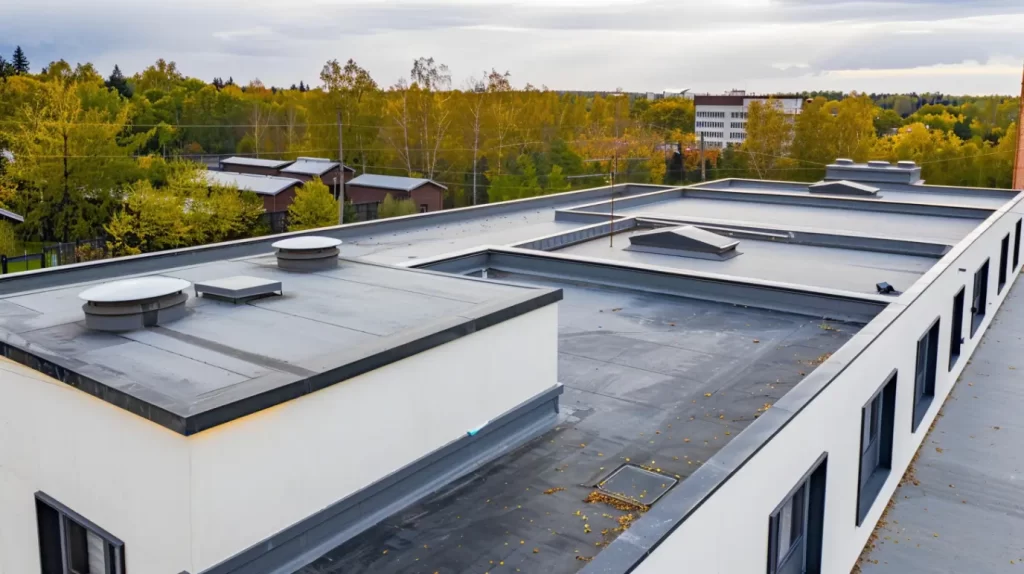
Impact of Poor Drainage on Roof Life
Inadequate drainage systems can create significant issues for roofing. Water pooling leads to intrusion and accelerates material degradation, potentially damaging the roof membrane and structure over time. This may result in costly repairs or the need for a new roof. Regular maintenance and timely inspections are crucial for mitigating these risks and enhancing the roof’s resilience against weather.
Building owners should ensure effective drainage performance, as well-functioning systems extend the lifespan of commercial roofs, safeguarding their investments.
Damage from Poor Drainage
Poor drainage can bring up many problems for commercial roofs. When water pooling happens on the roof surface, it may cause structural damage and lead to big repairs. With time, you might even need a full roof replacement. Stagnant water can break down the roofing membrane. It can also create mold, which is not good for those in the building.
In colder climates, ice can build up and form ice dams. This puts more stress on the roof and makes drainage problems worse.
Impact on Roofing Membranes and Structure
Water accumulation occurs when roof runoff management is inadequate, leading to significant issues for roofing materials and building structure. Prolonged standing water can seep into materials, accelerating degradation and shortening roof lifespan.
Trapped water also exerts pressure on the roof deck, worsening structural problems and increasing the risk of extensive damage. To prevent costly repairs or full replacements, it’s essential to maintain effective water flow systems.
Proper drainage safeguards the building’s foundation, reduces maintenance costs, and protects both the roof and deck from water buildup.
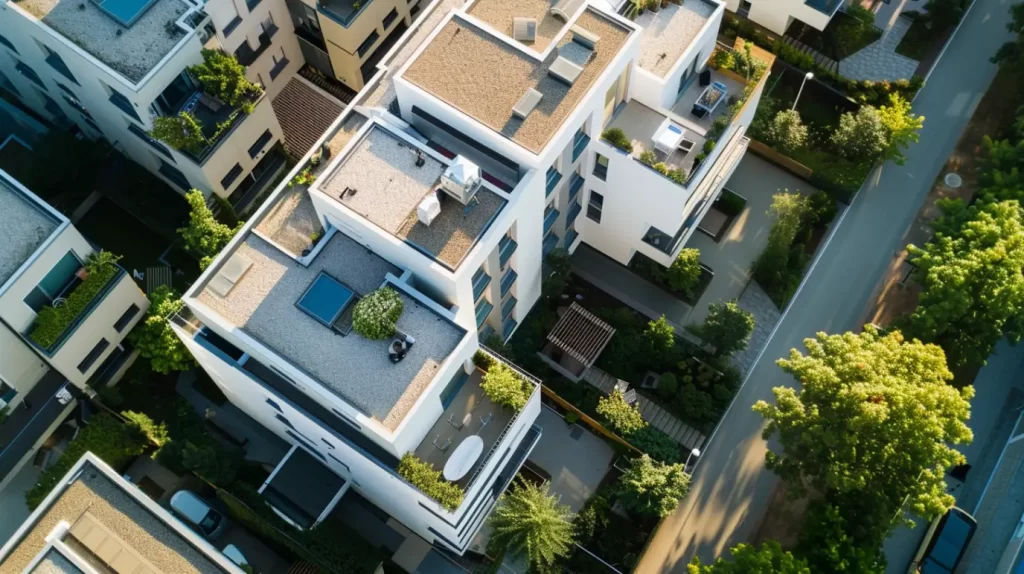
Design Factors for Effective Drainage
Effective water runoff control begins with key factors. The roof slope is crucial for directing water away and preventing accumulation. A slight incline guides water to runoff points, reducing potential issues in commercial roofing.
Drain placement is also vital; optimal locations enhance runoff performance. Attention to details improves the entire roofing system.
Consider components like parapet walls and roof edges, which aid in proper drainage. Using quality materials and proper setup extends the roof’s lifespan, safeguarding the building and minimizing costly repairs.
Impact of Roof Shape and Slope
Roof shape and steepness significantly impact drainage performance. Even a slight slope directs water to drainage points, preventing stagnation and extensive damage. Well-planned roof structures ensure proper water flow, reducing the risk of material degradation and costly repairs. Building owners collaborating with roofing professionals during early planning can optimize drainage efficiency, ensuring their roofs remain strong and functional for years.
Selecting Proper Drain Locations and Sizes
Choosing the right spots and sizes for roof drains is essential for maintaining steady water flow in large buildings. Properly placed drains facilitate quick water removal, preventing pooling and moisture intrusion that can cause damage. The building’s design, including flat roofs or parapet walls, influences drain placement. Collaborating with roofing professionals is wise, as they understand the roofing system and can recommend optimal drain placements. Effective drainage enhances roof longevity and reduces the risk of expensive moisture damage repairs.
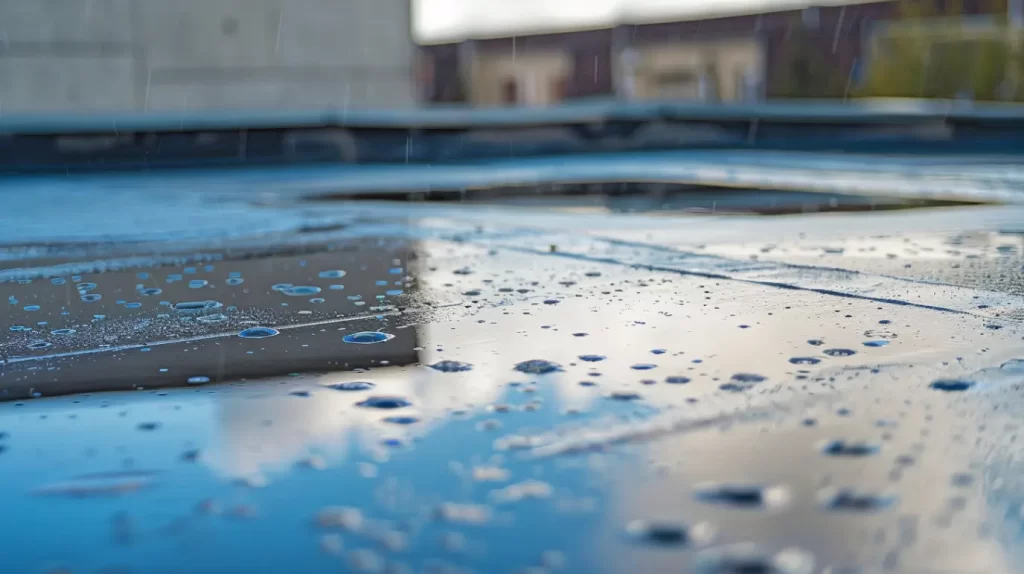
Tips to Prevent Drainage Issues
Routine inspections are essential for maintaining drainage systems in large commercial buildings. Regular debris removal and water pooling checks facilitate early issue detection. Hiring professional roofing contractors improves drainage performance and extends roofing material lifespan. As a GAF Master Elite Contractor, Certainteed Shingle Master, and Polyglass Preferred Contractor, we prioritize quality. Clearing debris from drainage points enhances system efficiency. As TRI certified professionals and members of CACM, CAI, and NRCA, we maintain high standards. Proper maintenance ensures effective moisture runoff, preventing costly repairs, supported by our expertise as Fiber Tite approved and IB Roofing Systems Authorized Applicators.
Property Manager Inspection Checklist
A solid inspection checklist helps property managers maintain large commercial buildings. Start with the roof surface; remove debris that can block water flow and cause drainage issues. Inspect all drainage points, both inside and outside, to ensure proper function and prevent pooling. Check roofing materials for moisture stains or damage, and verify that parapet walls are in good condition. Regular maintenance strengthens the roof and reduces long-term repair costs.
Recognizing Warning Signs of Drainage System Failure
Visible signs like pooling on the roof or ice dams indicate drainage issues. Regular checks can reveal small changes, such as moisture stains on ceilings or walls, which may signal leaks. Debris near drainage points can obstruct water flow, leading to costly repairs if ignored. Addressing these problems early keeps your roofing system in top condition and prevents larger structural issues.
Get in Touch
Proper drainage is crucial for the longevity of commercial roofing. Fontaine Roofing in Anaheim, CA, emphasizes the importance of effective drainage systems and regular maintenance to prevent costly repairs and moisture damage. Awareness of debris accumulation and drainage performance is essential for maintaining roof integrity. Collaborating with experienced professionals like Fontaine Roofing yields better outcomes, enhancing the roofing system’s reliability and protecting it from adverse weather conditions.
Read our blog: Sloped vs. Flat Roofs in High-Density Housing
Frequently Asked Questions
What hidden costs can arise from neglected roof drainage in large complexes?
When you ignore roof drainage in big buildings, you may face many problems. Moisture damage can cause you to pay a lot on repairs. You may also spend more money on energy because the insulation will not work well. Poor drainage can lead to more costs when tenants complain or take legal action. At the end, poor water runoff management can lower the value of the building and push you to pay for upgrades.ades.
What are the first signs that a roof drainage system may need repairs?
Early signs that there be a problem with your roof drainage system can include water pooling on the roof, leaks or moisture stains inside the building, and buildup of debris in the gutters or downspouts. If you see these in or on the roof, it be smart to fix the issue right away. Doing so can stop damage and help you avoid costly repairs.
What is most affected by drainage issues?
Runoff issues can make your roof wear out faster. When there is not enough moisture removal, water pooling happens.This can hurt both the roofing membranes and the roof’s frame. It can also make the roof not last as long. Even the structure of your building can get weaker if water pooling does not get fixed.

